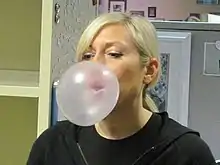Bubble gum
Bubble gum is a type of chewing gum, designed to be inflated out of the mouth as a bubble.
 Woman blowing a bubble | |
| Type | Chewing gum |
|---|---|
| Place of origin | United States |
| Region or state | Pennsylvania |
| Created by | Walter Diemer |
| Invented | 1928 |
Bubblegum flavor
While there is a well-known "bubblegum flavor" – which artificial flavorings called esters are mixed to obtain – it varies from one company to another.[1] Esters used in synthetic bubblegum flavoring may include methyl salicylate, ethyl butyrate, benzyl acetate, amyl acetate or cinnamic aldehyde.[2] A natural bubblegum flavoring can be produced by combining banana, pineapple, cinnamon, cloves, and wintergreen.[3] Vanilla, cherry, lemon, and orange oil have also been suggested as ingredients.[2]
Composition
In modern chewing gum, if natural rubber such as chicle is used, it must pass several purity and cleanliness tests. However, most modern types of chewing gum use synthetic gum based materials. These materials allow for longer lasting flavor, a better texture, and a reduction in tackiness.[4]
History
In 1928, Walter Diemer, an accountant for the Fleer Chewing Gum Company in Philadelphia, was experimenting with new gum recipes. One recipe, based on a formula for a chewing gum called "Blibber Blubber", was found to be less sticky than regular chewing gum, and stretched more easily. This gum became highly successful and was eventually named by the president of Fleer as Dubble Bubble because of its stretchy texture.
This remained the dominant brand of bubble gum until after WWII, when Bazooka bubble gum entered the market.[5]
Until the 1970s, bubble gum still tended to stick to one's face. At that time, synthetic gum was introduced, which would almost never stick as a bubble popped. The first brands in the US to use these new synthetic gum bases were Hubba Bubba and Bubble Yum.
Bubble gum got its distinctive pink color because the original recipe Diemer worked on produced a dingy gray colored gum, so he added red dye (diluted to pink) as that was the only dye he had on hand at the time.[6]
Flavors

In taste tests, children tend to prefer strawberry and blue raspberry flavors, rejecting more complex flavors as they say these make them want to swallow the gum rather than continue chewing.[7]
Records
In 1996, Susan Montgomery Williams of Fresno, California set the Guinness World Record for largest bubblegum bubble ever blown, which was 26 inches (66 cm) in diameter. Chad Fell though holds the record for "Largest Hands-free Bubblegum Bubble" at 20 inches (51 cm), achieved on 24 April 2004.[8]
Tourism
Bubblegum Alley is a tourist attraction in downtown San Luis Obispo, California, known for its accumulation of used bubble gum on the walls of an alley.
The Market Theater Gum Wall is a brick wall covered in used chewing gum located in an alleyway in Post Alley under Pike Place Market in Downtown Seattle.
References
- The Strange Recipe Behind 'Bubble Gum Flavor'
- Base Notes – Bubblegum
- [https://candyflavor.com/How_To_Make_Bubble_Gum_Flavor.html How to make Bubble Gum Flavor]
- "TLC Cooking "What is chewing gum made of?"". Recipes.howstuffworks.com. 1 April 2000. Retrieved 15 November 2012.
- The Invention and History of Bubble Gum
- "What was chewing gum originally made from?". madehow.com/. 22 April 2007. Retrieved 31 March 2014.
- McGrath, Susan. Stuck On Bubble Gum. National Geographic World 277. Readers' Guide Full Text Mega (H.W. Wilson).
- "Largest Bubblegum Bubble Blown". guinnessworldrecords.com. Guinness Book of World Records. Archived from the original on 31 October 2011. Retrieved 2 November 2011.
